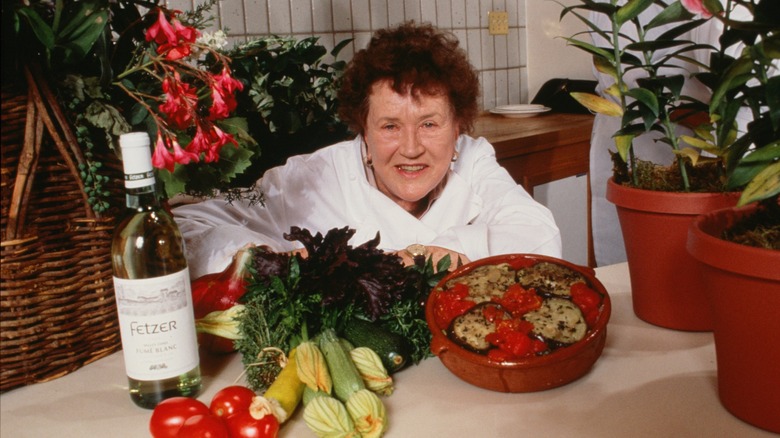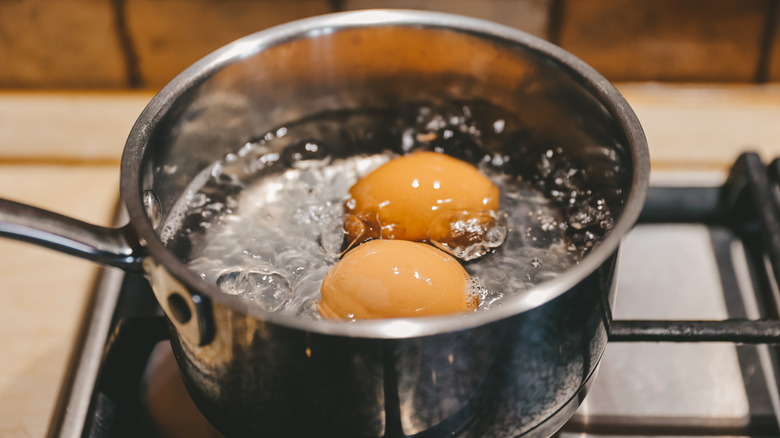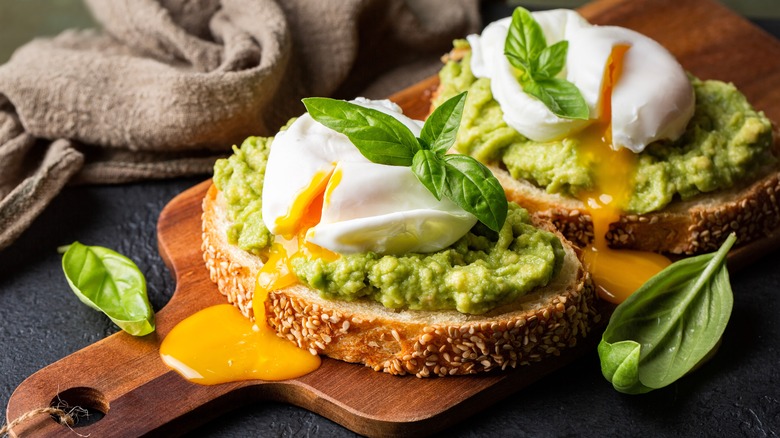Julia Child's Shell Trick For Picture Perfect Poached Eggs
With their softly set whites and runny golden yolks, poached eggs make a light yet delicious breakfast or brunch dish, as well as providing a tasty topper for asparagus, grain bowls, or salads any time of day. But let's not pretend that poaching is the simplest way to cook eggs; it's easy to under- or overcook them, resulting in a disappointingly slimy or rubbery texture. And as for getting that encased eggy pouch to look just the right shape for picture-perfect presentation, well, that's even trickier.
If you've ever cracked your egg into the pan of hot water to see the white spreading out and becoming a wispy mess, you'll know that preparing poached eggs, especially if you're cooking them for other people, can be a little daunting. But culinary legend Julia Child had a tip that solves the issue, by ensuring that the eggs keep their shape every time. It doesn't involve any special equipment; just a pin, a pan, and giving the egg a brief spell in boiling water before you even think about cracking the shell.
The method is straightforward enough, starting with pricking the large end of the egg with a pin, which lets any air out and prevents cracked shells. Then, Child advised popping the eggs, still in their shells, into boiling water for just eight to 10 seconds. When the eggs are then cracked into hot water to poach, it means that they stay perfectly formed.
Julia Child quickly boiled eggs in the shell before poaching
One piece of advice that always comes up when poaching is to use eggs that are as fresh as possible; it's why you should make poached eggs as soon as you buy the carton for the best results. The texture of the whites becomes more watery as they age, which increases the likelihood of wispy bits, so using fresh eggs helps the whites and yolk to stay together tightly. But if you don't happen to have extremely fresh eggs to hand, or you're not sure exactly how fresh they are, then the beauty of Julia Child's shell trick is that it doesn't matter quite so much.
The key to Child's method is the few seconds that the eggs spend in boiling water while still in their shells. It means that the eggs are already on their way to a nicely rounded oval shape since the whites have started to firm up a little even before the poaching process starts.
Child's technique involved lowering the poked eggs gently into a pan of boiling water using a slotted spoon, waiting ten seconds before lifting them out, and then cracking them into a wide shallow pan of simmering water to poach. And if the eggs still need a little helping hand to keep their shape, Child liked to give them a gentle nudge with a spatula in the water to help them retain their roundness.
More tips for prettier poached eggs every time
Many chefs and home cooks like to use a little vinegar to help poached eggs keep a firmer shape, as it helps the whites to coagulate more quickly. And Julia Child was no exception, adding a tablespoon or two of white vinegar per quart of water. If you're not keen on the tangy taste, then Child advised placing the eggs in a bowl of cold water once poached, which removes the vinegar as well as prevents the eggs from cooking further.
But there are other ways to get a picture-perfect egg without using vinegar at all. And there's a simple tool you need for richer poached eggs that you probably have in your kitchen: a mesh strainer. Cracking the egg into a strainer before poaching means that any watery bits of white will drain away, leaving the thicker parts behind, which results in a neater poached egg. Or have a go at the muffin tin hack that makes poaching eggs way easier, with each muffin cup offering a round structure to house a perfectly shaped egg.
Of course, you could always resort to using an egg poacher or silicone cup to hold the eggs in shape for a truly tidy result; even Julia Child sometimes relied on a perforated metal egg poacher for a little extra help. But perhaps try Child's quick boil method first, for an Instagram-worthy result with no special kit.



